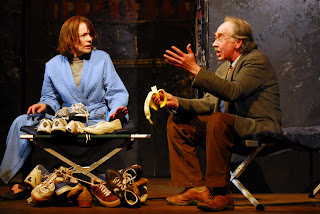and so it goes. written and directed by george f. walker
produced by factory theatre
photographs by ed gass-donnelly
l-r: martha burns,jerry franken
“I’m scared,” says twenty-five year old Karen staring from her window at the ominous man loitering around her father’s car at the onset of George F. Walker’s new play And So It Goes, now playing at the Factory Theatre until February 28th, 2010. Fear is the catalyst for the various means of coping and survival in this play as each of the characters fight to keep themselves from disappearing into the abyss beyond the shadows of the city.
Before the ominous man and the household shrouded in fear, Ned and his wife Gwen had a comfortable and stable life with their two children, yet things began to deteriorate very quickly when their daughter Karen got lost in the throes of Schizophrenia. With their world spiralling out of control and their son having abandoned ship years ago, Ned and Gwen find themselves overwhelmed with the struggles of caring for a daughter they don’t recognize, and can’t trust or understand, coupled with a harsh world filled with economic recessions and disappearing jobs.
In this play, Walker focuses on his characters’ coping strategies, how they shift and evolve, and most fascinatingly, how they can bring someone to the very brink of annihilation and then, how they can encourage that same person to take a step back from the edge. Gwen seeks stability from within her own mind and creates her own psychologist in the form of imagined conversations with the late American satirist Kurt Vonnegut. In this way, she is able to control Vonnegut’s reactions to her admissions of her true feelings and reactions to her situation with Karen. This is especially interesting because it insinuates that all the wisdom that helps Gwen to survive is all there within herself. Ned’s coping skills are more scattered, he adopts his own version of Vonnegut, throws himself into Cooking School, and eventually becomes consumed by the idea of finding the right person to blame for his daughter’s demise, for the socio-economic plight of his city and all the corruption, the violence and unfairness that has ruined the world.
The nuances and complexities of these characters are brilliantly constructed in four incredible performances. Jerry Franken is witty and composed as the imaginary Vonnegut while still having an element of the ephemeral about him, as though his mind were always a bit distracted by the clouds. It is also interesting to watch the subtle shifts in Vonnegut’s character when he is being imagined by Ned as opposed to when he is imagined by Gwen. Martha Burns is fascinating as Gwen, a woman with so much sadness in her eyes, who continues to push forward with the ultimate resolve and strength of character, at times embracing selfishness, and at times admitting defeat or sinking into denial, but always fighting to keep treading water. Jenny Young gives an incredible performance as Karen, capturing a fierce sense of intense rage and exposing the vulnerability that continually peaks out of Karen’s wild, guarded irrationality. Peter Donaldson’s Ned is remarkably likeable, even at time admirable, because Donaldson commits so genuinely to his rich relationships with each of the characters onstage. Despite his fear, his anger, his feelings of helplessness and failure, at his essence, Donaldson infuses Ned with unconditional love for his wife and his daughter.
I was particularly struck by George F. Walker’s use of blackouts throughout this play. As a director, Walker positioned each scene as a short, punchy vignette of life within this world and most frequently the lights were cut with a short, crisp blackout. I felt this not only created a sense of disjunction which connected nicely to Karen’s state of mind, but also that it alluded to the characters’ fears of disappearing. Less frequently the lights faded more slowly, as though they were closing in around them, which was also evocative of the idea that the world was closing in on these people and leaving them in darkness.
There is a line in the play that says, “The future is only possible if you make a leap,” And So It Goes takes place within that leap, as all the characters are flying and flailing through space, unsure where they will wind up, or if they will even land safely at all. For an audience watching these characters hurtle through life devoid of its usual structure is a fascinating examination of human behaviour and emphasises how little separates us from our fear of having all we have worked so hard to accumulate suddenly crumble to dust. And yet, it becomes clear, even with nothing, the strongest among us keep leaping and keeping going.
And So It Goes plays at Factory Theatre (125 Bathurst Street (at Adelaide)) until February 28th, 2010. For more information and to book tickets please call 416.504.9971 or visit online at http://www.factorytheatre.ca/







